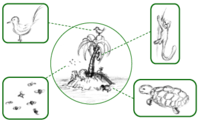
Photo from wikipedia
BackgroundMethodological applications of the high sensitivity genus-specific Schistosoma CAA strip test, allowing detection of single worm active infections (ultimate sensitivity), are discussed for efficient utilization in sample pooling strategies. Besides… Click to show full abstract
BackgroundMethodological applications of the high sensitivity genus-specific Schistosoma CAA strip test, allowing detection of single worm active infections (ultimate sensitivity), are discussed for efficient utilization in sample pooling strategies. Besides relevant cost reduction, pooling of samples rather than individual testing can provide valuable data for large scale mapping, surveillance, and monitoring.MethodThe laboratory-based CAA strip test utilizes luminescent quantitative up-converting phosphor (UCP) reporter particles and a rapid user-friendly lateral flow (LF) assay format. The test includes a sample preparation step that permits virtually unlimited sample concentration with urine, reaching ultimate sensitivity (single worm detection) at 100% specificity. This facilitates testing large urine pools from many individuals with minimal loss of sensitivity and specificity. The test determines the average CAA level of the individuals in the pool thus indicating overall worm burden and prevalence. When requiring test results at the individual level, smaller pools need to be analysed with the pool-size based on expected prevalence or when unknown, on the average CAA level of a larger group; CAA negative pools do not require individual test results and thus reduce the number of tests.ResultsStraightforward pooling strategies indicate that at sub-population level the CAA strip test is an efficient assay for general mapping, identification of hotspots, determination of stratified infection levels, and accurate monitoring of mass drug administrations (MDA). At the individual level, the number of tests can be reduced i.e. in low endemic settings as the pool size can be increased as opposed to prevalence decrease.ConclusionsAt the sub-population level, average CAA concentrations determined in urine pools can be an appropriate measure indicating worm burden. Pooling strategies allowing this type of large scale testing are feasible with the various CAA strip test formats and do not affect sensitivity and specificity. It allows cost efficient stratified testing and monitoring of worm burden at the sub-population level, ideally for large-scale surveillance generating hard data for performance of MDA programs and strategic planning when moving towards transmission-stop and elimination.
Journal Title: Infectious Diseases of Poverty
Year Published: 2017
Link to full text (if available)
Share on Social Media: Sign Up to like & get
recommendations!